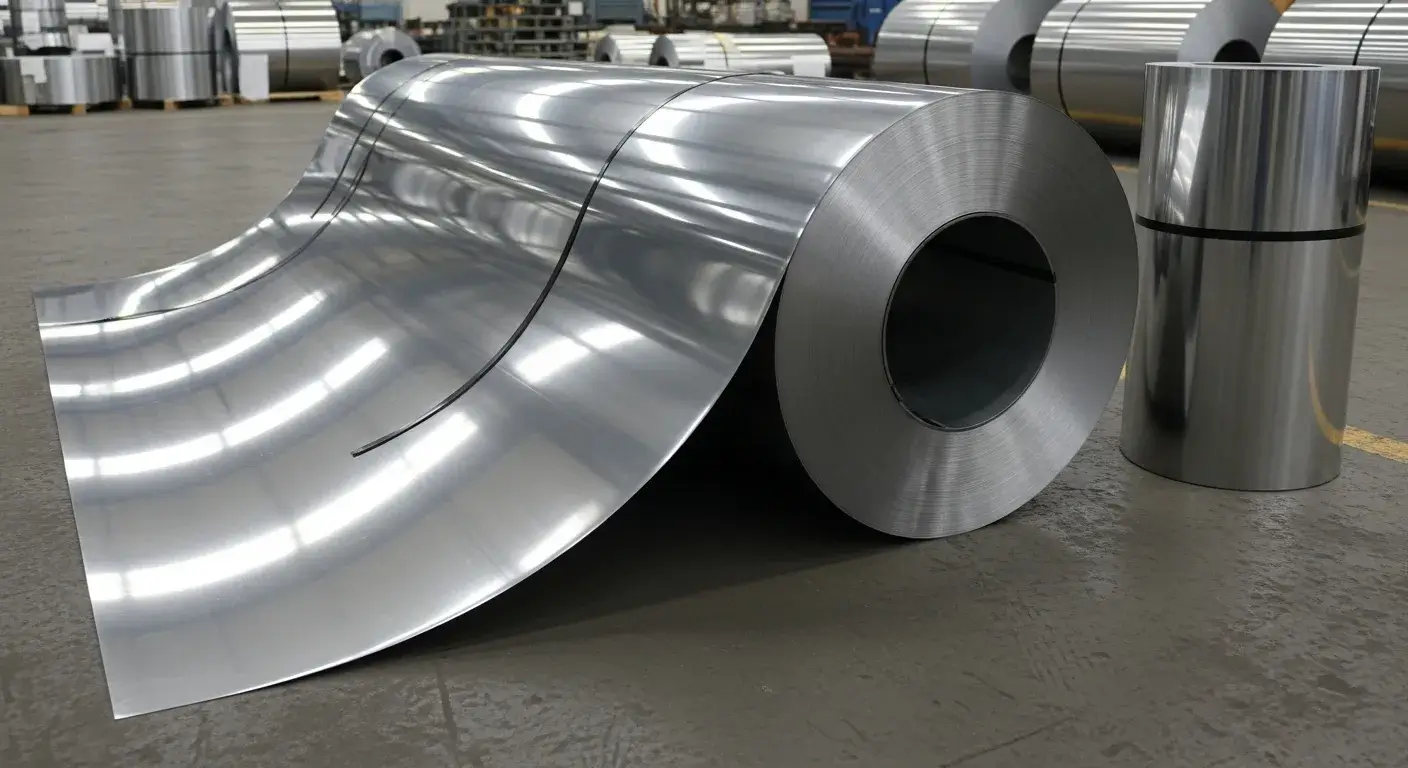
Quick Reference: 201 Stainless Steel Properties for Drinkware
| Property | 201 Stainless Steel | 304 Stainless Steel | 316 Stainless Steel |
|---|---|---|---|
| Chromium Content | 16-18% | 18-20% | 16-18% |
| Nickel Content | 3.5-5.5% | 8-10.5% | 10-12% |
| Manganese Content | 5.5-7.5% | ≤2% | ≤2% |
| Cost Comparison | Most Affordable | 20-30% Higher | 40-50% Higher |
| Corrosion Resistance | Moderate | Good | Excellent |
| Food Safety | FDA Approved* | FDA Approved | FDA Approved |
| Best Applications | Budget drinkware, promotional items | Premium water bottles | Marine/harsh environments |
*FDA approved for low-corrosion food contact applications
What is 201 Stainless Steel? The Complete Guide for Drinkware Buyers
201 stainless steel is a cost-effective, austenitic chromium-nickel-manganese alloy that has become increasingly popular in the drinkware industry. Moreover, this versatile material offers manufacturers and buyers an affordable alternative to premium grades like 304 stainless steel. However, understanding its properties, benefits, and limitations is crucial for making informed purchasing decisions.
Essentially, 201 stainless steel was developed to reduce dependence on expensive nickel while maintaining good formability and moderate corrosion resistance. Furthermore, this grade meets international standards including ASTM A240 and EN 1.4372, making it suitable for various drinkware applications.
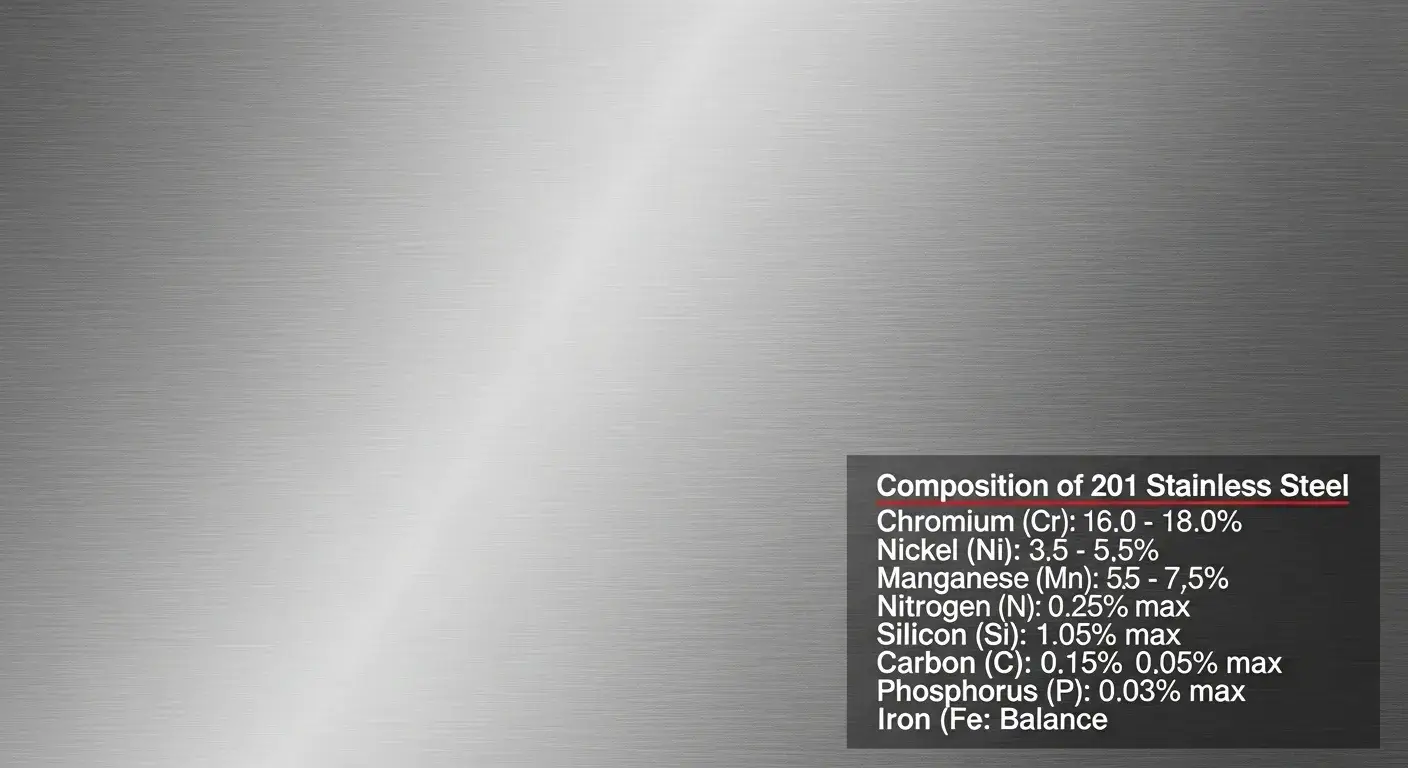
Molecular structure diagram showing 201 stainless steel composition
201 Stainless Steel Quick Facts (What Buyers Need to Know)
Chemical Composition Breakdown
The unique composition of 201 stainless steel directly impacts its performance in drinkware applications:
- Chromium (16-18%): Provides the primary corrosion resistance through passive oxide layer formation
- Nickel (3.5-5.5%): Lower than 304 grade, reducing cost but affecting corrosion resistance
- Manganese (5.5-7.5%): Higher content compensates for reduced nickel, maintaining austenitic structure
- Nitrogen (0.25%): Enhances strength and stability
- Carbon (≤0.15%): Slightly higher than 304, affecting weldability
Key Certifications and Standards
Quality 201 stainless steel for drinkware applications typically meets:
- FDA standards for food contact surfaces
- LFGB certification for European markets
- ASTM A240 specifications
- ISO 9001 manufacturing standards
Professional manufacturers like Sibottle ensure all products meet these critical safety standards, providing buyers with confidence in their drinkware sourcing decisions.

FDA and LFGB certification symbols with 201 stainless steel products
Is 201 Stainless Steel Good Quality for Water Bottles?
Yes, 201 stainless steel offers good quality for specific water bottle applications, particularly when cost-effectiveness is a priority. However, the definition of "good quality" depends on your intended use case and environment.
When 201 Performs Well:
- Indoor office environments with controlled humidity
- Promotional water bottles for short-term campaigns
- Budget-conscious bulk orders for corporate events
- Temperate climate usage without extreme temperature variations
Performance Limitations:
- High-humidity environments may accelerate surface oxidation
- Acidic beverages can cause faster deterioration than with 304 grade
- Marine environments are not recommended due to chloride sensitivity
- Long-term daily use may show wear faster than premium grades
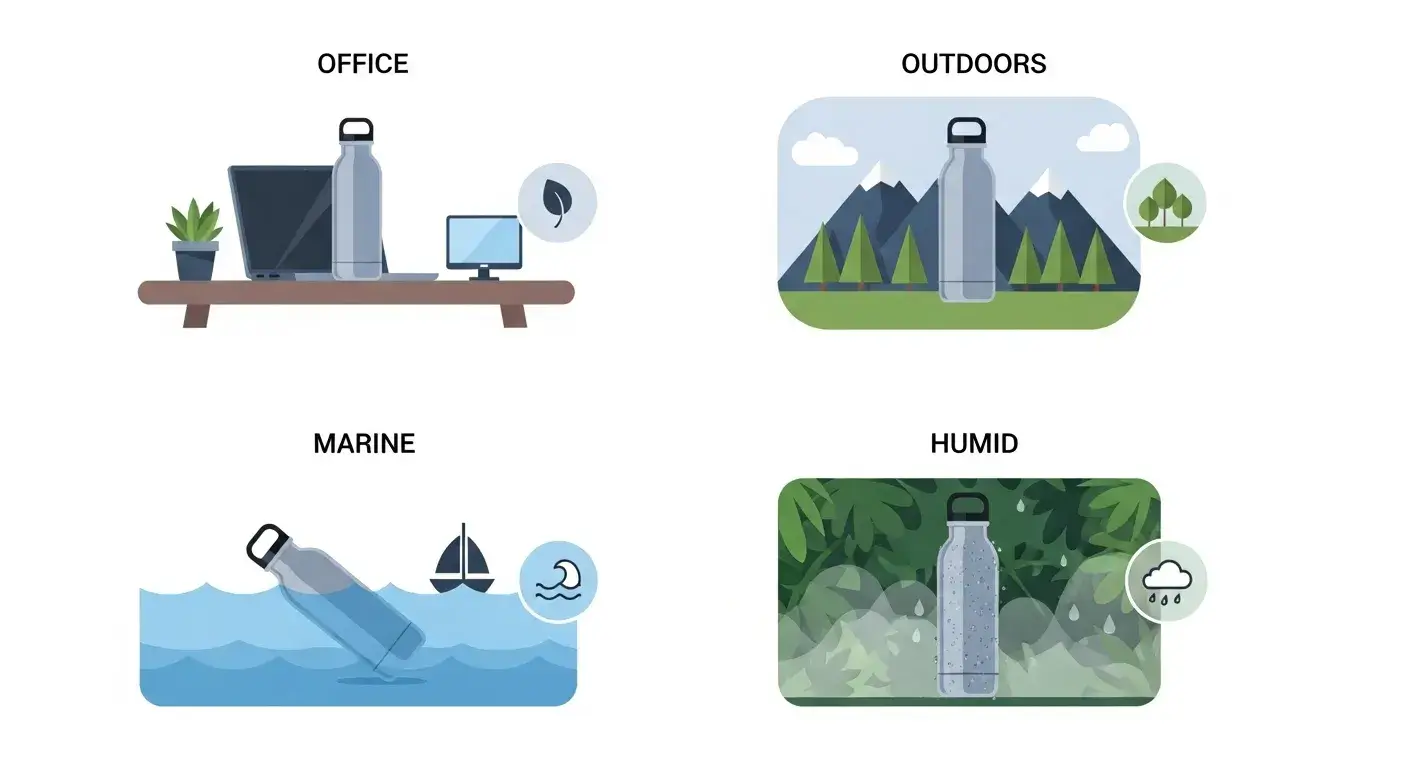
According to industry data from the International Stainless Steel Forum, 201 stainless steel accounts for approximately 10% of global drinkware production, primarily in cost-sensitive markets.
201 vs 304 Stainless Steel: Which is Better for Drinkware?
The choice between 201 and 304 stainless steel ultimately depends on your specific requirements, budget, and target market. Furthermore, understanding the key differences helps buyers make informed decisions.
Cost Analysis:
- 201 Grade: 20-30% lower cost than 304
- 304 Grade: Premium pricing but superior longevity
- Break-even point: Typically reached after 2-3 years of regular use
Performance Comparison:
201 Stainless Steel Advantages:
- Lower material costs enable competitive pricing
- Good formability for complex designs
- Adequate corrosion resistance for indoor use
- Meets basic food safety standards
304 Stainless Steel Advantages:
- Superior corrosion resistance in all environments
- Better performance with acidic beverages
- Longer lifespan reduces replacement costs
- Premium brand positioning
Market Applications:
Choose 201 When:
- Budget is the primary concern
- Large quantity promotional orders
- Indoor/office environment usage
- Short to medium-term campaigns
Choose 304 When:
- Premium brand positioning required
- Outdoor or marine environments
- Daily use with various beverages
- Long-term customer satisfaction critical
As a leading stainless steel water bottle manufacturer, we help clients choose the right grade based on their specific market needs and budget constraints.
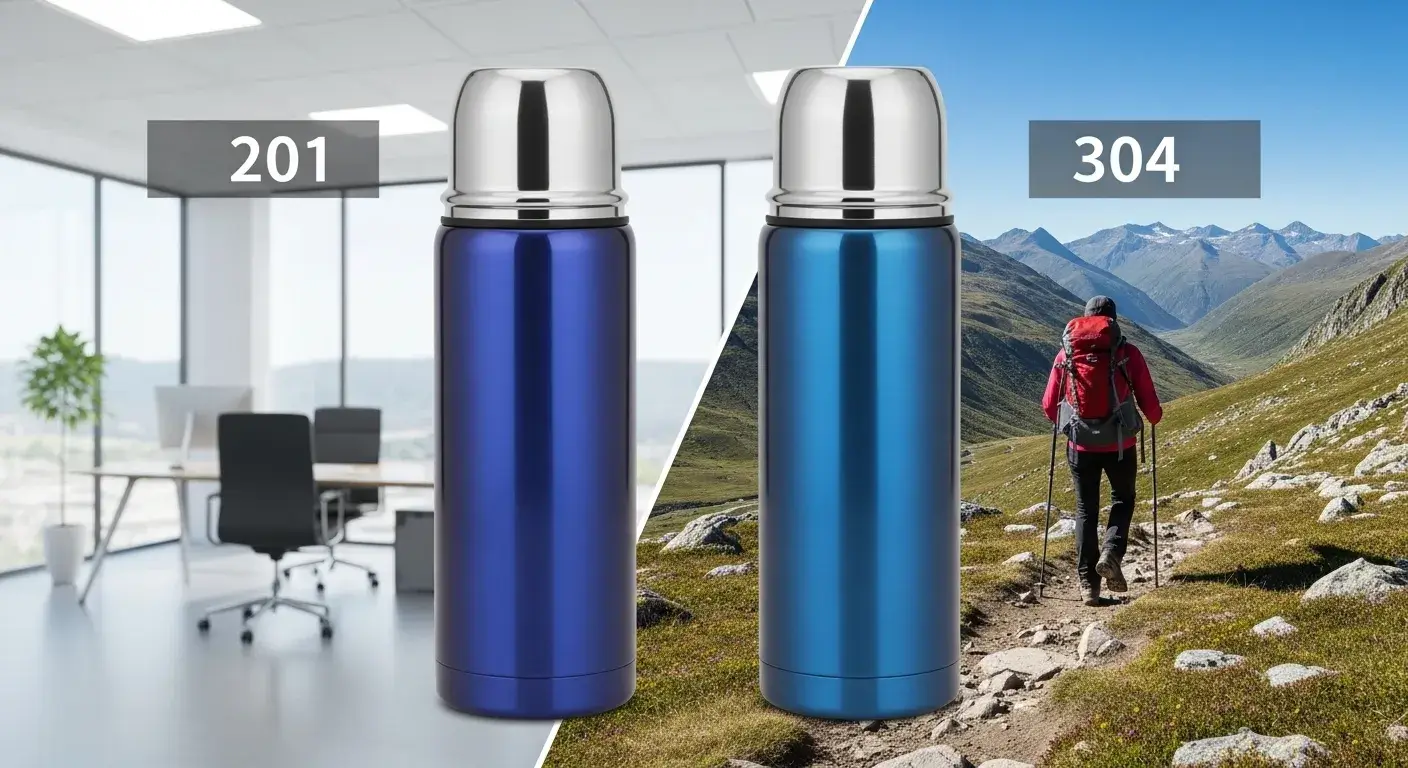
Side-by-side comparison of 201 and 304 water bottles in different environments
Will 201 Stainless Steel Rust or Tarnish in Water Bottles?
201 stainless steel can develop surface oxidation under certain conditions, but true rust formation is rare when properly maintained. However, understanding the factors that influence corrosion helps buyers set appropriate expectations.
Corrosion Resistance Factors:
Environmental Conditions:
- Dry indoor environments: Excellent performance
- High humidity areas: Moderate performance with proper care
- Coastal/marine locations: Not recommended due to salt air exposure
- Industrial areas: May show accelerated wear from pollutants
Does 201 Stainless Steel Turn Green?
No, quality 201 stainless steel does not turn green under normal drinkware usage conditions. However, green discoloration can occur if:
- Copper contamination exists in the manufacturing process
- Poor quality alloys are used instead of genuine 201 grade
- Chemical reactions occur with specific cleaning products
Tarnishing and Discoloration:
201 stainless steel may show:
- Light surface oxidation appearing as dull spots
- Water stains in hard water areas
- Fingerprint marks more readily than 304 grade
- Minor discoloration after extended acidic beverage contact
Prevention Strategies:
- Regular cleaning with mild soap and water
- Thorough drying after each use
- Avoid chlorine-based cleaners that can damage the surface
- Periodic deep cleaning with specialized stainless steel cleaners
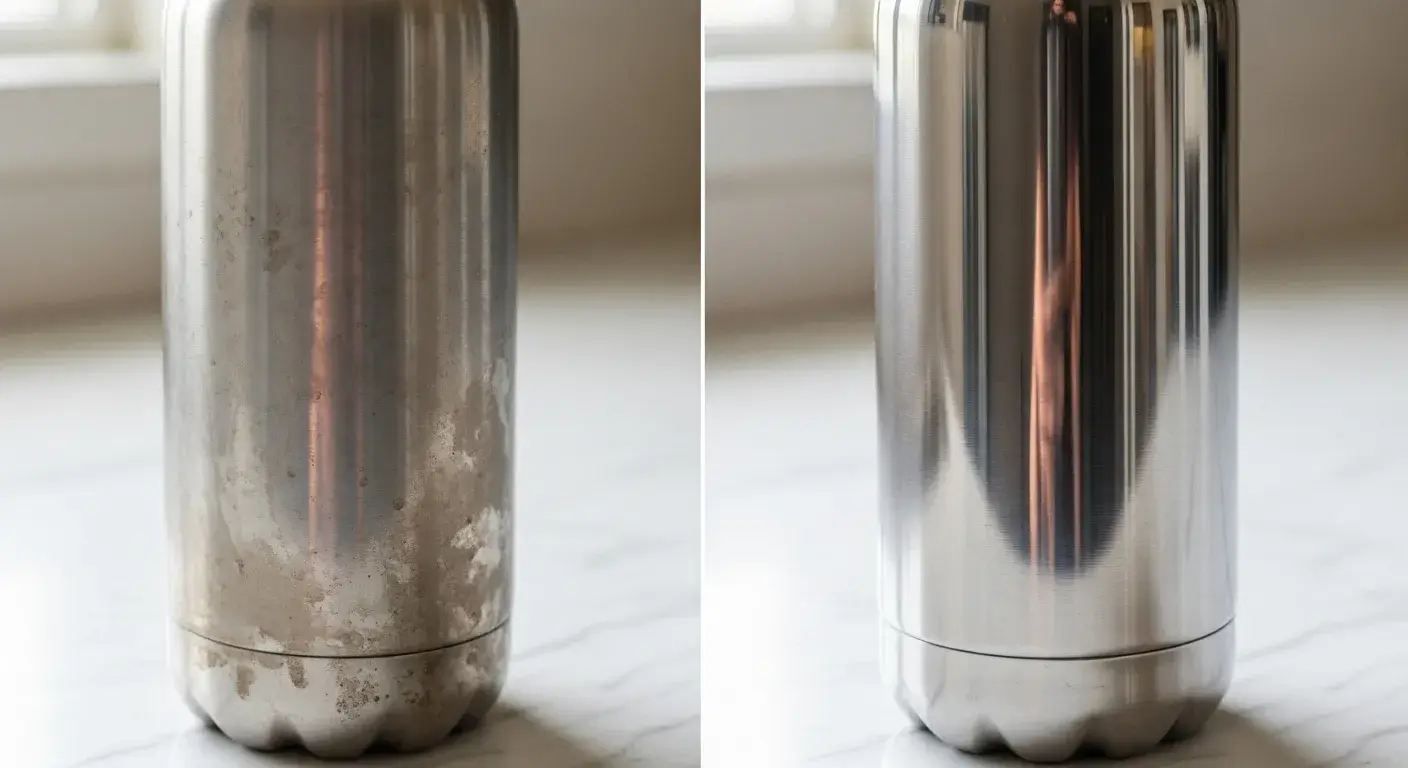
Before and after photos showing proper 201 stainless steel maintenance results
201 Stainless Steel for Different Drinkware Applications
Understanding how 201 stainless steel performs across various drinkware categories helps buyers make targeted decisions for their specific product lines.
Water Bottles Performance:
Single-Wall Water Bottles:
- Excellent for promotional and corporate gifts
- Good cost-performance ratio for bulk orders
- Suitable for room temperature beverages
- Limited thermal insulation properties
Double-Wall Insulated Bottles:
The complete guide on stainless steel water bottle manufacturing explains how 201 grade performs well in vacuum-insulated designs where the inner wall has minimal exposure to external elements.
Coffee Mugs and Tumblers:
Travel Mugs:
- Adequate for coffee and tea at moderate temperatures
- Good heat retention when double-walled
- Suitable for office and commuter use
- Cost-effective for promotional campaigns
Professional insulated steel tumbler manufacturers often recommend 201 grade for budget-conscious customers who prioritize affordability over premium performance.
When 201 is NOT Recommended:
Avoid 201 for:
- Premium gift sets requiring long-term durability
- Sports bottles for intense outdoor activities
- Marine applications due to salt water exposure
- Acidic beverage storage like citrus juices for extended periods
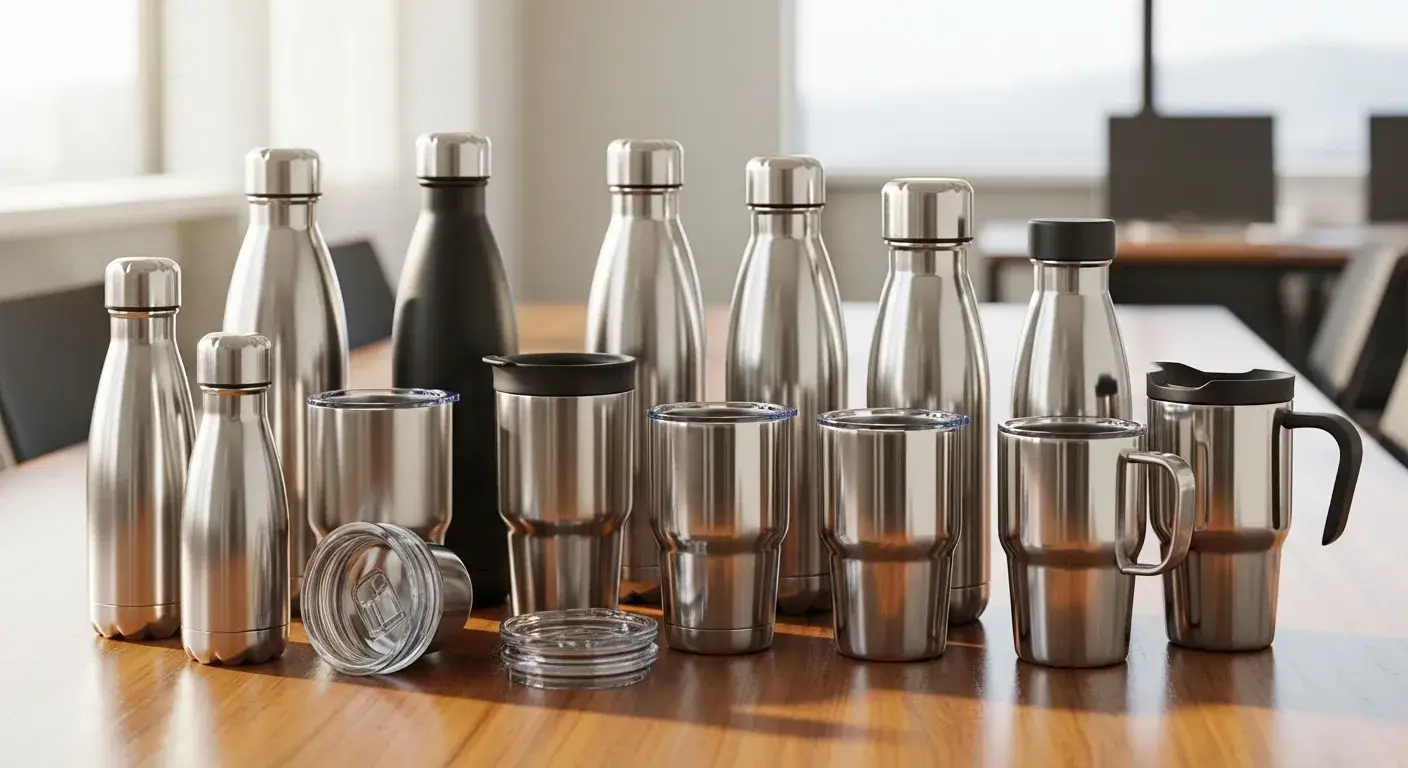
Various drinkware applications showing 201 stainless steel performance ratings
How to Identify Quality 201 Stainless Steel (Buyer's Guide)
Ensuring you receive genuine, quality 201 stainless steel requires understanding proper identification methods and verification processes.
Is Stainless 201 Magnetic?
201 stainless steel magnetism varies based on processing:
- Annealed state: Non-magnetic due to austenitic structure
- After cold working: Becomes slightly magnetic from work hardening
- Formed products: May show magnetic properties from manufacturing processes
Important: The magnet test alone cannot reliably identify 201 grade, as magnetism depends on processing history rather than composition.
Professional Verification Methods:
Chemical Analysis:
- XRF testing confirms elemental composition
- Mill certificates provide guaranteed analysis
- Third-party testing ensures grade authenticity
Visual Inspection:
- Bright, uniform surface finish
- No visible inclusions or surface defects
- Consistent grain structure when examined closely
Documentation Requirements:
Essential Certificates:
- Mill Test Certificate (MTC) with chemical analysis
- ASTM A240 compliance documentation
- Food safety certifications (FDA, LFGB)
- ISO 9001 manufacturing quality assurance
Reputable suppliers like those found through Sibottle's manufacturing network provide complete documentation packages with each order.
Red Flags to Avoid:
Warning Signs:
- Unusually low pricing compared to market rates
- No mill certificates or quality documentation
- Inconsistent magnetic properties across samples
- Poor surface finish or visible defects
- Reluctance to provide chemical analysis data
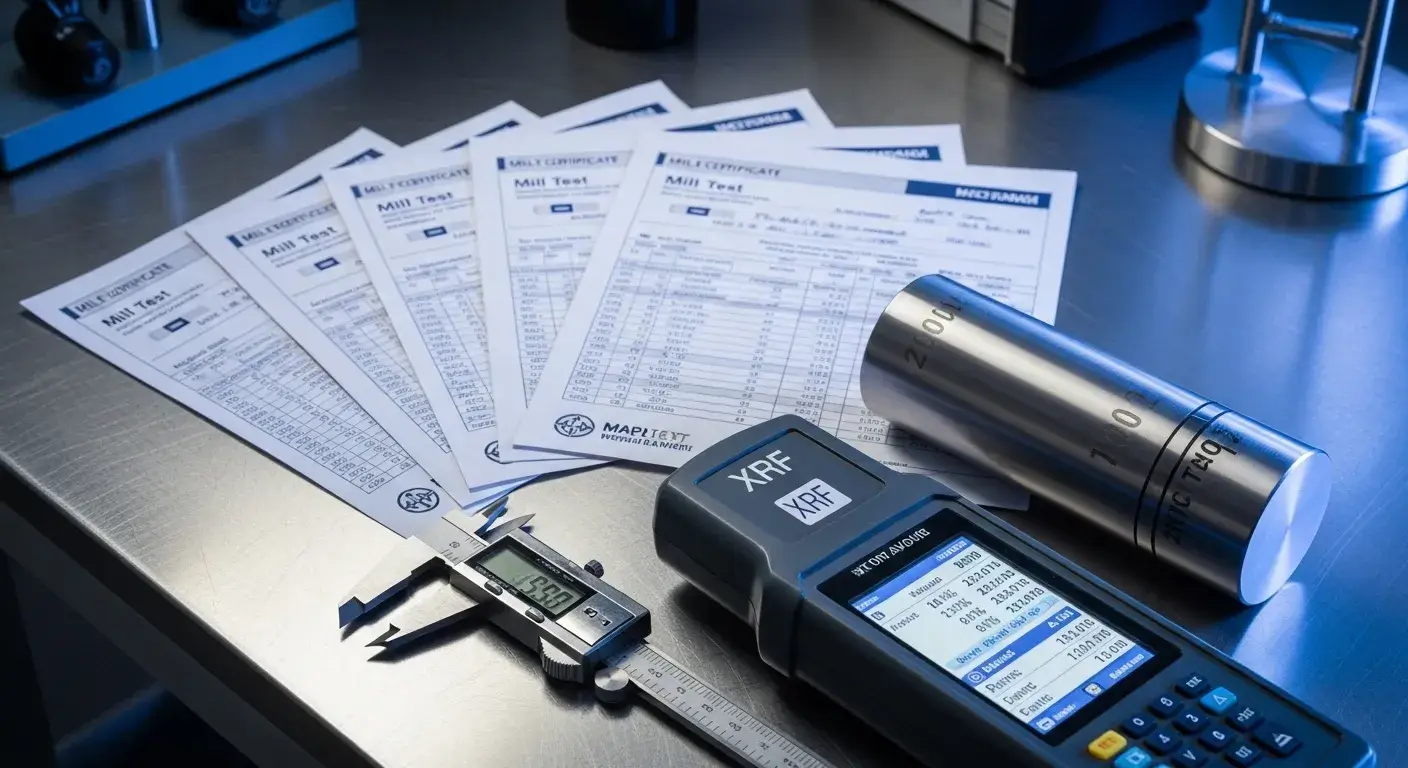
Testing equipment and certification documents for 201 stainless steel verification
201 Stainless Steel Pricing: What to Expect
Understanding market pricing for 201 stainless steel helps buyers budget effectively and identify fair value propositions in the marketplace.
Current Market Pricing (2025):
Raw Material Costs:
- 201 stainless steel: $2,800-3,200 per metric ton
- 304 stainless steel: $3,600-4,200 per metric ton (30% premium)
- 316 stainless steel: $4,800-5,500 per metric ton (70% premium)
Source: London Metal Exchange and industry reports
Finished Product Pricing:
Water Bottle Price Ranges (FOB China):
- 201 grade bottles: $2.50-4.00 per unit (500ml capacity)
- 304 grade bottles: $3.20-5.50 per unit (500ml capacity)
- Minimum order quantities: Typically 500-1,000 pieces
Cost-Benefit Analysis:
Break-Even Calculation:
For promotional campaigns lasting 6-12 months, 201 stainless steel offers optimal cost-performance. However, for premium retail brands targeting long-term customer relationships, the 304 grade investment typically pays off through reduced warranty claims and enhanced brand reputation.
Market Pricing Trends:
Factors Affecting Pricing:
- Nickel commodity prices (major cost driver)
- Manufacturing capacity utilization rates
- Trade policies and tariff structures
- Environmental regulations affecting production costs
According to industry analysis from Steel Dynamics, 201 stainless steel pricing has remained relatively stable due to its reduced nickel dependency compared to premium grades.
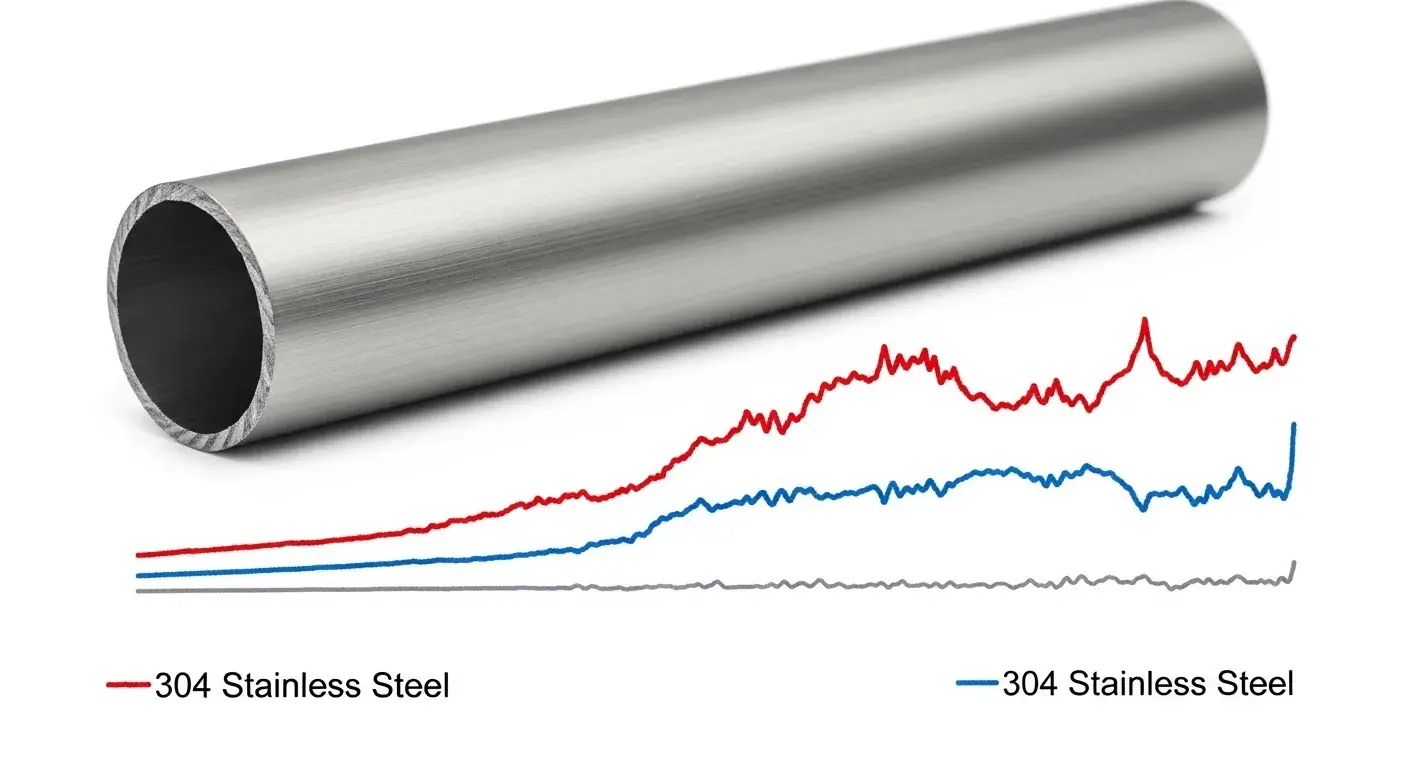
Price trend chart showing 201 vs 304 stainless steel costs over time
Best Practices for 201 Stainless Steel Drinkware
Maximizing the performance and lifespan of 201 stainless steel drinkware requires following specific maintenance and manufacturing guidelines.
Maintenance and Care:
Daily Cleaning Protocol:
- Rinse immediately after use with clean water
- Wash with mild soap and soft cloth or sponge
- Dry thoroughly to prevent water spots
- Avoid abrasive cleaners that can scratch the surface
Deep Cleaning (Weekly):
- White vinegar solution (1:1 ratio with water) removes mineral deposits
- Baking soda paste eliminates odors and stains
- Specialized stainless steel cleaners restore original luster
Manufacturing Considerations:
Design Optimization:
- Avoid sharp internal corners that trap bacteria
- Smooth internal surfaces facilitate easy cleaning
- Proper welding techniques prevent intergranular corrosion
- Quality control testing ensures consistent performance
Professional manufacturers following comprehensive manufacturing guides implement these best practices to maximize 201 grade performance.
Quality Control Tips:
Incoming Material Inspection:
- Chemical composition verification against specifications
- Surface finish assessment for uniformity
- Mechanical property testing confirms grade standards
- Cleanliness evaluation ensures food-safe conditions
Production Monitoring:
- Welding parameter control prevents defects
- Temperature management during forming operations
- Final inspection protocols catch potential issues
- Packaging protection maintains product integrity
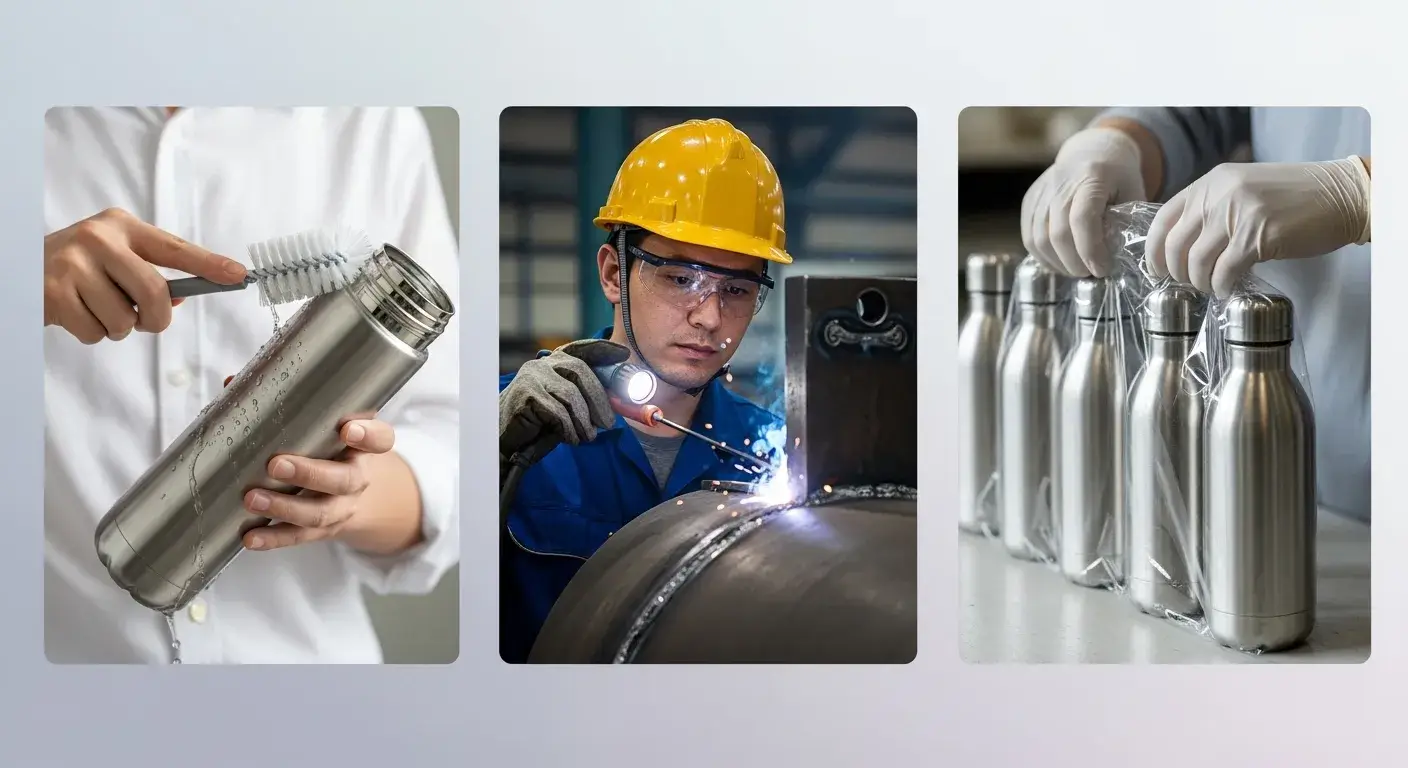
Quality control process showing inspection and testing procedures for 201 stainless steel
Frequently Asked Questions
What is considered the best stainless steel?
316 stainless steel is generally considered the best for demanding applications due to its superior corrosion resistance from molybdenum content. However, "best" depends on specific requirements:
- 316 grade: Marine environments, medical applications, harsh chemicals
- 304 grade: Food service, general industrial, premium drinkware
- 201 grade: Cost-sensitive applications, promotional items, indoor use
What is the most expensive stainless steel?
Super austenitic and duplex stainless steels are typically the most expensive, costing 3-5 times more than 201 grade. However, among common drinkware grades:
- 316L: Most expensive (premium applications)
- 304: Moderate premium pricing
- 201: Most cost-effective option
Additional Common Concerns:
Can I use 201 stainless steel for hot beverages?
Yes, 201 stainless steel handles hot beverages well up to normal consumption temperatures (60-70°C). However, extended exposure to very hot liquids may accelerate surface oxidation compared to 304 grade.
How long does 201 stainless steel last?
With proper care, 201 stainless steel drinkware typically lasts 2-5 years in normal use conditions. Furthermore, premium grades like 304 may last 5-10 years or longer in similar conditions.
Does 201 stainless steel affect taste?
High-quality 201 stainless steel should not affect beverage taste when properly manufactured and cleaned. However, surface oxidation or poor manufacturing can sometimes impart metallic flavors.
Making the Right Choice for Your Business
Selecting the appropriate stainless steel grade for your drinkware business requires balancing multiple factors including cost, performance requirements, target market expectations, and long-term business objectives.
Decision Framework:
Choose 201 Stainless Steel When:
- Budget constraints are primary consideration
- Promotional or short-term campaign focus
- Indoor office or controlled environment usage
- High-volume orders with cost sensitivity
- Entry-level market positioning
Consider Upgrading to 304 When:
- Premium brand positioning required
- Outdoor or variable environment usage
- Long-term customer satisfaction critical
- Acidic beverage contact expected
- Warranty concerns exist
Market Positioning Strategy:
201 Grade Market Position:
- Value-oriented customer segments
- Promotional products and corporate gifts
- Budget retail channels
- Entry-level product lines
Successful Implementation:
Companies like those working with Sibottle successfully position 201 grade products by clearly communicating value propositions and appropriate use cases to customers.
Quality Assurance Recommendations:
Supplier Selection Criteria:
- Proven track record in stainless steel manufacturing
- Complete certification documentation
- Quality control processes and testing capabilities
- Customer service and communication standards
- Production capacity matching your volume needs
Long-term Partnership Benefits:
Working with established manufacturers ensures consistent quality, reliable delivery schedules, and technical support for product development initiatives.
Ready to Source Quality 201 Stainless Steel Drinkware?
Get expert guidance on choosing the right stainless steel grade for your drinkware business needs.
Why Choose Sibottle:
- 14+ years expertise in stainless steel manufacturing
- 1000+ designs with low 1000-piece MOQ
- 12-hour response time for all inquiries
- Free samples and competitive pricing
Get your quote now and find the perfect balance of quality, cost, and performance for your market.

